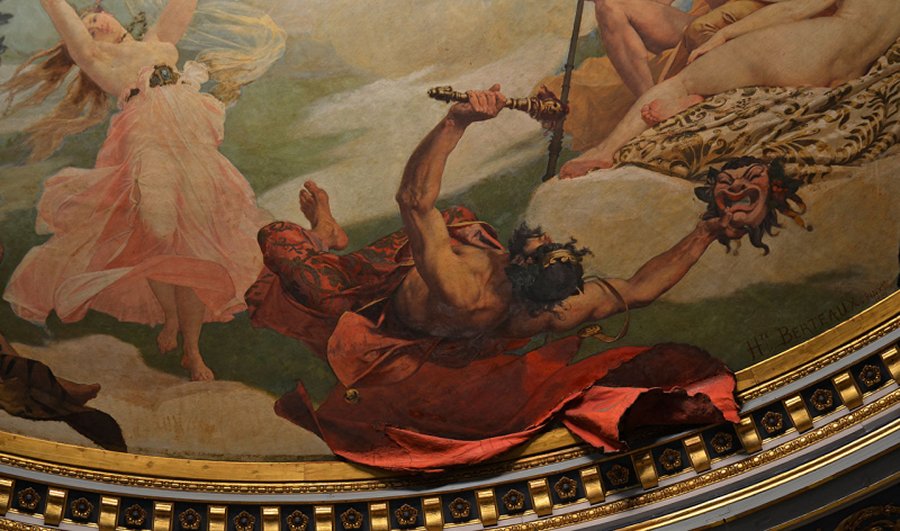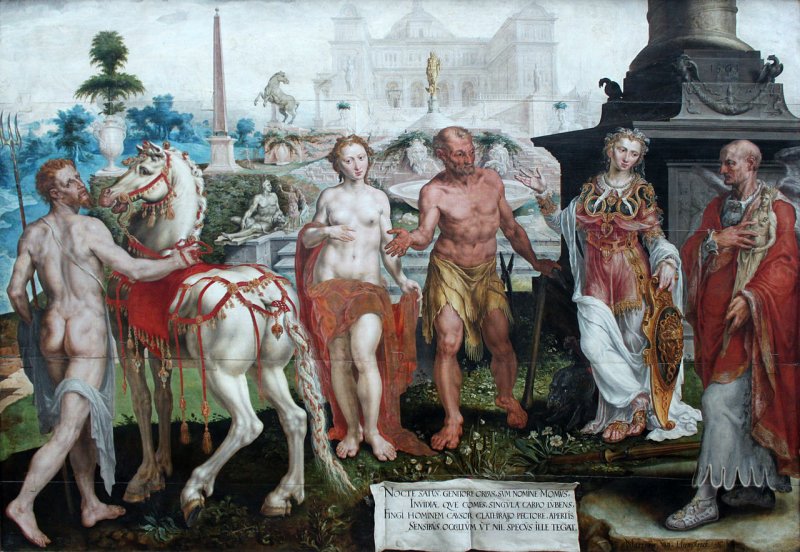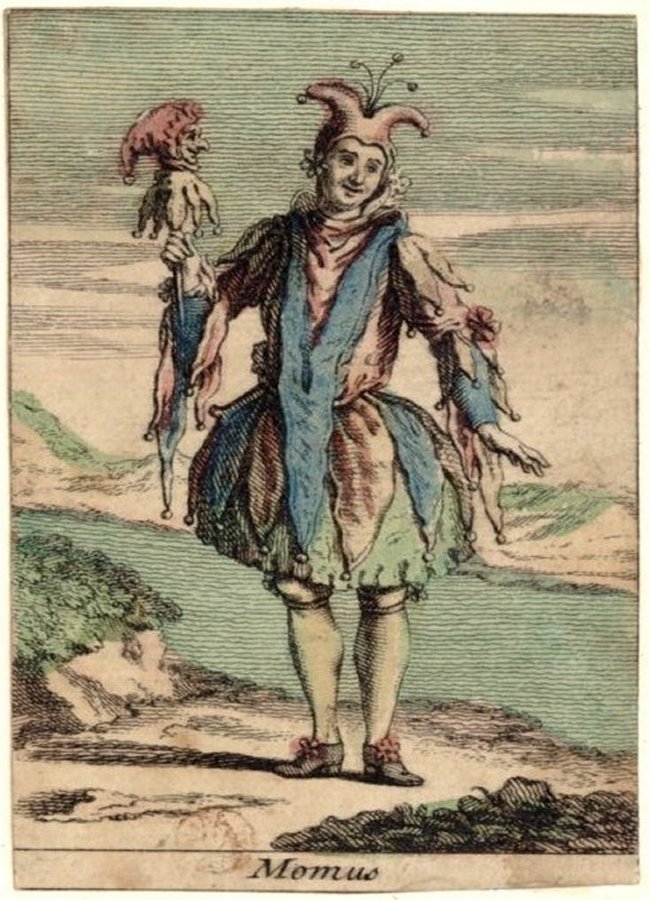A. Sutherland – AncientPages.com – According to the Theogony by Hesiod (8th – 7th century BC), Momus was initially an advisor to the Olympian gods. Still, he was thrown to the Earth due to exaggerated, unpleasant, and constant criticism towards others.

Momus, god of satire and mockery – Painting by Hippolyte Berteaux, Théâtre Graslin ceiling – Nantes. Image credit: Selbymay – CC BY-SA 3.0
Momus was considered a less favorable figure among the minor deities of the Olympians. As such, he was less liked by them compared to other Greek divinities.
The Greek pantheon was very diverse. Each god had a separate range of activities, attributes, and weaknesses. The Greek gods differ from the gods of the great monotheistic religions—Momus displays many characteristics similar to those of humans.
Sophocles, one of classical Athens’s most celebrated tragic playwrights, wrote a satire drama devoted to Momus, the son of Nyx, who was the god of joking and ridicule. He loved to criticize and make fun of others. His opinions were expressed with bitter sarcasm.
Momus, the god of criticism, was never a welcomed companion for the gods on Mount Olympus, but he was one of them, so he was tolerated.
His irony and undeserved criticism were often interpreted as simply malignant. Sometimes, he had difficulty finding something particularly wrong in the actions of gods and men, but he always tried.
Furthermore, his approach towards people was inappropriate and lacked friendliness

Momus Criticizes the Gods’ Creations, by Maarten van Heemskerck, 1561, Gemäldegalerie, Berlin. Public Domain.
As a matter of fact, Momus disliked humans and wished to see Earth’s population decrease. An excellent example in the mythology of the Greeks is the Trojan War, waged against the city of Troy by the Achaeans (Greeks) after Paris of Troy took Helen from her husband Menelaus, king of Sparta.
He often made successful attempts to discover some flaws or weaknesses in all things.
Sometimes, he could also show up and accuse those who thought they had escaped with some crime. He was not particularly impressed when Prometheus’ Fire Bringer,’ a hero who stole fire from the gods to give it to the mortals, created the first man.
He wouldn’t be himself if he didn’t criticize Prometheus’ divine work. So, he deemed his work unfinished. According to him, there was no opening in the breast through which his thoughts might be seen, and his dishonesty could be prevented.
He also criticized Athena for the construction of the house built for man. Momus pointed out that the house lacked the necessary means of locomotion. He suggested that her creation for a human should have wheels so a person could freely move from one place to another if required.
Aphrodite, the goddess whose domain was beauty, the pleasures of the flesh, fertility, and procreation, alone resisted his criticism. Momus could find no fault for his great disappointment with her perfect form. However, he accused her of talking too much and wearing peculiar, creaky sandals.

“The Fool” (Momus) is from an 18th-century minchiate playing card deck. Image credit: Desconhecido – Public Domain
In “Lucian and the Latins: Humor and Humanism in the Early Renaissance,” David Marsh writes that one occasion, at the banquet, “condemns philosophers, priests, and scholars as atheists. Despite the protests of Hercules and Juno, the god Jupiter accepts Momus’s proposal to destroy the world and to plan a new creation.”
“The gods visit the Earth to consult human philosophers, among whom they declare Socrates alone the only one truly wise man. Returning to Olympus, the gods ᴀssemble but soon fall to squabbling.
When Juno insults Momus, he proposes a law to exclude all female deities from the ᴀssembly. The enraged goddesses attack Momus and castrate him. Meanwhile, the people on Earth, fearing new disasters, seek to appropriate the gods by dedicating new temples and statues to them.
In heaven, the grateful gods now praise mankind and denounce the maimed Momus, whom Jupiter banishes to be chained on an ocean cliff…”
In what manner the ancients represented this god is not precisely known. He is depicted as a king’s clown in modern art, with a fool’s cap and bells, and sometimes as a man who often takes off a theatrical mask.
Momus is considered a relatively anonymous divine figure, except that he was the son of Nyx, the personification of the night. He was also mother to Hypnos (Sleep) and Thanatos (Death), with Erebus (Darkness). According to Hesiod, Momus had no father but a twin sister, Oizys, the goddess of depression and misery. He drove the gods mad with his eternal disapproval of everything. He finally called Zeus a Sєx maniac and a violent individual.
It was enough for Zeus, who kicked Momus out of Olympus.
The Greeks had many gods that personified life and the natural world—like mortal beings, the gods, demigods, and mythological heroes displayed human-like negative traits, emotions, and more or less hostile atтιтudes.
The actions of these figures have given rise to numerous intriguing legends and myths, thereby establishing Greek mythology as a significant heritage of this ancient civilization.![]()
Article in Portuguese – here
Updated on February 8, 2024
Written by – A. Sutherland – AncientPages.com Senior Staff Writer
Copyright © AncientPages.com All rights reserved. This material may not be published, broadcast, rewritten or redistributed in whole or part without the express written permission of AncientPages.com
Expand for references
References:
Marjorie Leach: Uniwersalny leksykon bóstw.
Grimal P. Słownik mitologii greckiej i rzymskiej.
The Theogony of Hesiod, translation: Hugh G. Evelyn-White
Kaster, J. Mytologisk uppslagsbok





